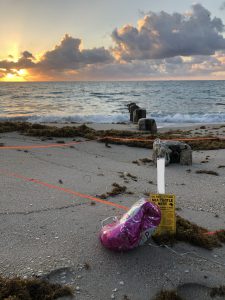By Ana Zangroniz, Florida Sea Grant Extension Agent & Leanne Hauptman, Miami-Dade County Sea Turtle Conservation Program
Now that sea turtle nesting season is in full swing, the Miami-Dade County Sea Turtle Conservation Program staff have their hands full-not just with data sheets and stakes, but unfortunately, with helium balloons recovered from the beach. Since the beaches were closed for the first official month of the 2020 nesting season due to COVID-19, staff experienced quieter and more relaxed conditions for performing surveys, as well as less debris left behind by beach-goers. That quickly changed as prom and graduation season arrived, with participants in search of new ways of celebrating these milestones. We certainly give credit to the creativity we’ve observed, from signs in front of home to car parades. However, the latter has often been seen with large bunches of balloons tied to car door handles and trunks.
What goes up must come down
While recognized as a symbol of celebration, helium balloons seem to collect on beaches at a disproportionately faster rate than other trash. Just like other debris, we figure that some of these balloons are lost by accident, as well as released intentionally as a symbolic gesture. These balloons can end up tangled in trees or eventually blow away and land in the ocean or on the shoreline, not only creating an eyesore on the water, but a hazard to marine organisms like sea turtles and shorebirds who could try to consume these balloons. Balloons, plastic and other debris items have been found in the gut contents of turtles, whales, fish, and birds.

There’s got to be a better way
Balloons are colorful, fun, and add a little extra charm to any special occasion but are detrimental to wildlife. The big question is, what can we do as an eco-friendly alternative to eliminate balloons? If you are using balloons to spell out a message, think of using a fun and vibrant banner. This alternative can be very environmentally friendly by using materials that are recyclable and biodegradable. Want to release balloons? How about blowing some bubbles or flying special kites (write your personalized message on the kite!). Wanting to add some color to your celebration? Use paper streamers or colorful string lights. Looking for a symbolic gesture? Throw some flowers in a body of water to let them drift away. Or write on a piece of paper everything you want to stay and gather around a fire. Ignite the paper in the fire and let the fire absorb your message, the smoke ascends and your message rises with it.
These great alternatives can help save the environment. Did you know that balloon debris ranks just behind fishing lines and plastic bags, as the most serious threat to marine wildlife?1 The Miami-Dade County Sea Turtle Conservation Program spends their mornings not only collecting data and marking off sea turtle nest but also picking up balloons they encounter almost daily. Marine turtle surveyors pick up anywhere from 10-30 balloons on any given day.
We encourage you to do your part in protecting and conserving our wildlife by being mindful the next time you want to decorate for a celebration or special occasion. Use these alternatives or think of your own fun and unique alternative! If you do happen to use balloons or attend a celebration where balloons are used, make sure to dispose of them properly! To dispose of a balloon, fully deflate it and cut the ribbon that is attached into small pieces. Throw it all away in the trash. Unfortunately, since balloons are made out of rubber they cannot be recycled, which is even more of a reason to use an eco-friendly alternative!
We protect what we love, so next time you think of how you are going to decorate for your special occasion, think eco-friendly, say no to balloons! The sea turtles and marine life will thank you.
References:
- Wilcox, C., Mallos, N. J., Leonard, G. H., Rodriguez, A., & Hardesty, B. D. 2016. Using expert elicitation to estimate the impacts of plastic pollution on marine wildlife. Marine Policy, 65, 107-114. doi:10.1016/j.marpol.2015.10.014
 1
1
